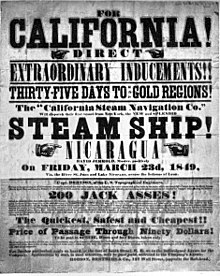Chinese Nicaraguans
| Total population | |
|---|---|
| 14,000[1] | |
| Regions with significant populations | |
| Bluefields, Puerto Cabezas, Managua | |
| Languages | |
| Spanish, Mandarin, Cantonese, Hokkien, others | |
| Religion | |
| Buddhism and Christianity | |
| Related ethnic groups | |
| Chinese Cubans, Overseas Chinese |
Chinese Nicaraguans (simplified Chinese: 尼加拉瓜华人; traditional Chinese: 尼加拉瓜華人; pinyin: Níjiālāguā huá rén; Spanish: Sino-nicaragüenses) are Nicaraguans of Chinese ancestry who immigrated to or born in Nicaragua. They are part of the Chinese diaspora.
Chinese people first arrived in Nicaragua's Caribbean coast in the latter part of the 19th century and most of them settled in cities such as
History
The
Many Chinese in Nicaragua committed themselves to the commerce industry and opened businesses.[5] They also dedicated themselves to the candy, soap, and clothing industries. They dominated the commerce of the main coastal towns on the Caribbean coast prior to 1979.
Immigration

Although information about when the Chinese first arrived in Nicaragua is scarce, Fernando Centeno Chiong, a Nicaraguan historian, journalist and university professor of Chinese descent, published an article in
"...It is possible that between the thousands of passengers who made that passage there were Chinese citizens who remained in Nicaragua, attracted by the natural beauty and the hospitality of a country that continues maintaining those same characteristics to the immigrants of different nationalities that have already made Nicaragua their second mother country."
— Fernando Centeno Chiong[8]
During that time, there were restrictions that prohibited the entrance of Asian citizens in the country,[5] in spite of which, many of them defied the prohibition and settled in what is thought to have been the first Chinese presence in the Americas, perhaps before the arrival of these citizens to Peru or Panama.[8]
Shortly after
Migration to the Pacific Coast
The Chinese had begun heading to the Pacific side of
Clubs and associations
Chinese Club and the Chinese Nicaraguan Association
The first club founded for Chinese Nicaraguans, Club Chino (Chinese Club), was conformed in the
Chinese Nicaraguan Association after the Sandinista revolution
During the
Other active clubs/associations include the Club de Jóvenes Chinos de Nicaragua (Club of Chinese Teens of Nicaragua).
Notable persons
- Sandinista revolution
See also
- Buddhism in Nicaragua
- Nicaragua
- Nicaraguan
- Demographics of Nicaragua
- Culture of Nicaragua
- Asian Latin American
Further reading
- Pineda, Baron (October 2001). "The Chinese Creoles of Nicaragua: Identity, Economy, and Revolution in a Caribbean Port City". Journal of Asian American Studies. 4 (3): 209–233. S2CID 144355584.
References
- ^ "Nicaragua: People groups". Joshua Project. Retrieved 2007-03-26.
- ^ Bolívar Juárez, Orient. "Bluefields, rostro de Nicaragua frente al Caribe". La Prensa (in Spanish). Archived from the original on 2007-02-06. Retrieved 2007-03-26.
- ^ Vásquez, Trinidad. "Fundación Cultural-Nicaragua-China promueven en rasgos de la mileria Cultura China". El Nuevo Diario (in Spanish). Archived from the original on 2008-03-15. Retrieved 2007-03-26.
- ^ www.bvsde.org.ni Archived May 26, 2007, at the Wayback Machine Los Chinos, ¶-2
- ^ a b c d Pardillo Gómez, Mayra (2005-04-10). "Los primeros chinos en Nicaragua". ARGENPRESS (in Spanish). Retrieved 2007-03-26. [dead link]
- ISBN 1-903471-14-1.
- ^ Vargas, Gerardo. "La Asociación China Nicaragüense celebra Año del Cerdo de Fuego". Bolsa de Noicias (in Spanish). Archived from the original on 2007-10-06. Retrieved 2007-08-17.
- ^ a b c d Centeno Chiong, Fernando. "Sobre la presencia de los chinos en Nicaragua". La Prensa (in Spanish). Archived from the original on 2007-09-27. Retrieved 2007-06-25.
- ISBN 0-521-84096-1.
- ^ "Nicaragua: International Religious Freedom Report; Section I. Religious Demography". U.S. State Department. Retrieved 2007-03-26.
- ^ "Embajada de la República de China (Taiwán) en Nicaragua". Archived from the original on 2007-03-19. Retrieved 2007-03-26.
- ^ "Languages of Nicaragua". Ethnologue. Retrieved 2007-03-26.
- ^ a b Wong Valle, Michell. "Comunidad China celebra día nacional". La Prensa (in Spanish). Archived from the original on 2007-08-23. Retrieved 2007-08-17.
External links
- Republic of China's Embassy in Nicaragua.
- LaPrensa.com Article on the Chinese Nicaraguan Association.
